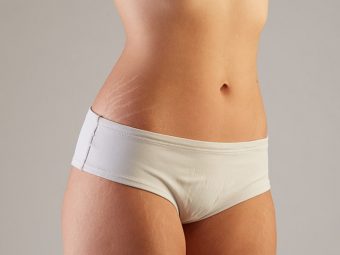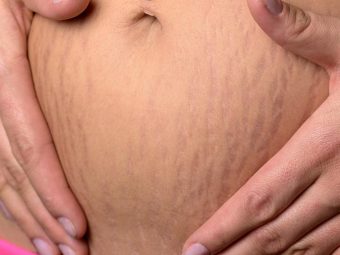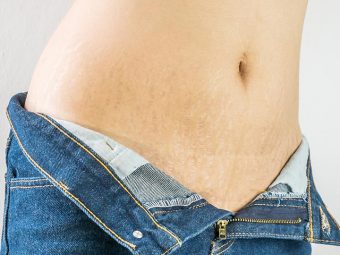10 Natural Ways To Reduce And Prevent Pregnancy Stretch Marks
Prevention is definitely better than cure when it comes to the stubborn stripes of momhood.

Image: shutterstock.com
As a new mama, you must be wondering how to remove pregnancy stretch marks! Stretch marks from pregnancy are very common. Basically, you put on weight as the fetus grows, which stretches the skin and produces stretch marks. The good news is that you can reduce their appearances with just a little tender loving care.
This article will show you how to reduce the look of stretch marks at home using natural treatments. Keep reading!
In This Article
What Causes Stretch Marks During Pregnancy?
Stretch marks are common during pregnancy. This is due to the skin’s inability to catch up with the body’s growth. The collagen and elastin fibers keep the skin taut. However, due to the weight gain during pregnancy, the collagen and elastin fibers stretch and snap, leaving pinkish streaks on your body, especially on areas like the stomach, buttocks, and breasts. Almost all women develop stretch marks during pregnancy.
When Do You Start Getting Stretch Marks During Pregnancy?
Stretch marks develop around 13 to 21 weeks of pregnancy. Fresh stretch marks appear pinkish and may itch. However, they may appear purple, brown, and red, depending on your skin tone.
While you cannot avoid stretch marks or get rid of them completely, you can improve their appearance. Here are a few natural ways to minimize stretch marks.
Natural Ways To Improve The Appearance Of Stretch Marks
Note: Home remedies and treatments work only early stretch marks. Once they turn white, it is tough to improve their appearance.
1. Use Natural Oils
Natural oils moisturize the skin and maintain its elasticity. This helps in reducing the appearance of stretch marks. Coconut and avocado oils help in collagen development. This may help improve the appearance of fresh stretch marks (1). Rosehip seed oil moisturizes the skin, and lavender oil promotes collagen synthesis (1), (2).
What You Will Need
- 1 tablespoon of carrier oil (coconut or avocado oils)
- 2-3 drops of essential oil (Grapeseed oil, hemp seed oil, lavender oil, rosehip oil)
What You Have To Do
- Mix the carrier and essential oils.
- Massage the affected area with this oil blend.
- Leave it on for several hours or overnight.
- Wash off the next day.
How Often You Should Do This
Apply this oil blend twice a day regularly.
2. Shea Butter
Shea butter can keep the skin moisturized and can be used as a preventive measure to improve the appearance of early stretch marks (1).
What You Will Need
- 1 tablespoon of raw shea butter
What You Have To Do
- Massage the affected with shea butter.
- Leave it on for several hours or overnight.
- Wash off the next day.
How Often You Should Do This
Do this twice a day.
3. Aloe Vera
Aloe vera gel moisturizes the skin and promotes collagen and elastin synthesis (3). This may help improve the appearance of early stretch marks.
What You Will Need
- A tablespoon of fresh aloe vera gel
What You Have To Do
- Massage the stretch marks with aloe vera gel.
- Leave it on to dry and rinse off.
How Often You Should Do This
Do this twice a day.
4. Petroleum Jelly
Petroleum jelly works as a shield and prevents moisture loss from the skin. This may keep the skin hydrated and prevent stretch marks. It is better to use a moisturizing cream and then layer it with petroleum jelly.
You Will Need
- 1 tablespoon of petroleum jelly
What You Have To Do
- Apply the petroleum jelly on the stretch marks.
- Massage for 5-10 minutes and leave it on.
How Often You Should Do This
Do this every night before going to bed.
5. Dry Brushing
Dry brushing can exfoliate your body and get rid of dead skin cells. This may soften the skin and minimize the appearance of stretch marks in the long run.
What You Will Need
- Body brush (with soft, natural bristles)
What You Have To Do
- Gently brush the affected area in circular upward motions for 5 minutes.
- Shower as usual and apply a good moisturizer.
How Often You Should Do This
Do this every alternate day before showering.
6. Egg Whites
The bioactive proteins and peptides in egg whites are used in anti-aging cosmeceuticals. They promote collagen synthesis and wound healing (4). This property may help improve the stretch marks.
What You Will Need
- 1 egg white
- A pastry brush
What You Have To Do
- Beat the egg white lightly.
- Spread it on the affected areas and let it dry.
- Rinse with cool water and moisturize.
How Often You Should Do This
Do this once every day.
7. Coffee Grounds
Caffeine can boost collagen synthesis (5). This can help heal stretch marks. The natural oils moisturize the skin and speed up the healing process.
You Will Need
- 1/2 cup coffee grounds
- 2 tablespoons of vegetable oil (use coconut or olive oils)
What You Have To Do
- Mix the coffee grounds and oil.
- Scrub the affected area with the mixture in circular motions.
- Leave the scrub on for five minutes and rinse off.
How Often You Should Do This
Use the scrub twice a week.
8. Apple Cider Vinegar
Anecdotal evidence suggests that apple cider vinegar spray may heal scars and blemishes. Using it on your stretch marks may lighten their appearance.
What You Will Need
- 1 cup of apple cider vinegar
- ½ cup of water
- Spray bottle
What You Have To Do
- Dilute the vinegar with water and pour it into a spray bottle.
- Spritz the mixture on the stretch marks and let it dry.
- Leave it on overnight.
- Shower as usual in the morning and follow up with a good moisturizer.
How Often You Should Do This
Repeat this every night before going to bed.
Note: If you have sensitive skin, add one cup of water to the solution to reduce its strength.
9. Baking Soda And Lemon
Baking soda is abrasive and may help in exfoliating the skin. Lemon extract is often used in skin whitening creams for its potential bleaching effect (6). This recipe may work as a natural skin exfoliator and lighten the stretch marks.
You Will Need
- 1 teaspoon of fresh lemon juice
- 1 tablespoon of baking soda
What You Have To Do
- Mix the ingredients and apply the mixture to the stretch marks.
- Let it dry for 10-15 minutes, and scrub it off gently.
- Rinse with water.
How Often You Should Do This
Do this once or twice a week.
Apart from natural methods, you may use topical treatments for stretch mark management.
Other Methods Of Treatment
- Tretinoin (Retinol): The topical application of 0.05% of tretinoin cream effectively reduces the severity of early stretch marks(7). It helps rebuild collagen, promoting faster healing.
Caution: Avoid using topical retinoids during pregnancy. Although there is no supportive evidence that topical retinoids can cause congenital disabilities, it is better to avoid using them.
Moreover, topical retinoids may cause photosensitivity. Avoid sun exposure after using them.
- Vitamin C: Topical vitamin C enhances collagen production and may help fade stretch marks (8). However, vitamin C can cause photodamage. Hence, ensure you avoid sun exposure after applying vitamin C.
- Hyaluronic Acid: Hyaluronic acid helps maintain skin hydration (9). Hydrated skin can maintain its elasticity. This may help improve early stretch marks.
Old stretch marks are difficult to manage. That is why early preventive measures help your skin heal in a better way and minimizes the visibility of stretch marks. Here are a few measures you may follow.
Tips To Prevent Stretch Marks
- Keep The Skin Moisturized: It is because moisturized skin is elastic and less prone to wear and tear caused by stretching. Use creams and lotions with natural oils and hydrating ingredients like hyaluronic acid, vitamin E, and glycerin.
- Consume Vitamin C-rich Foods: Foods rich in vitamin C promote collagen development and improve skin elasticity. Consume foods like oranges and lemons, sweet peppers, tomato, broccoli, kiwifruit, berries, and grapefruit.
- Use Products And Oils: You may also try products for improving stretch marks. Bio-oil is a popular product that may help reduce the appearance of your stretch marks. Read everything about Bio-oil here. Also, massage the area with plant oils for hydration.
- Use Petroleum Jelly: It helps soothe itching and redness caused by stretch marks.
- Exercise: Work out to reduce your post-pregnancy weight. Exercising tones the skin and may reduce the visibility of the marks. However, avoid drastic weight loss measures (like crash dieting). Work out under the supervision of an instructor. You may also use tummy tuckers to manage the excess inches while you work on them.
- Stay Hydrated: Regular intake of water helps improve skin elasticity.
Most of the remedies take time to show results. Before using any ingredient or remedy, keep in mind the following things.
Precautions
- Check the ingredients list and avoid any product that has artificial fragrances, preservatives, and alcohol. Consult a doctor for product recommendations, especially if you are pregnant or nursing.
- Do a patch test to rule out any possibility of allergic reactions.
- Set realistic expectations as stretch marks are permanent and may take longer to fade.
It is common to develop stretch marks during your pregnancy. As the stomach grows to accommodate the growing baby, the elastin and collagen fibers snap, resulting in pinkish-purplish stretch marks. If you are wondering about how to remove pregnancy stretch marks, using natural ingredients such as coconut oil, aloe vera, shea butter, and lemon juice can reduce the appearance of stretch marks over time. Eating a balanced diet, staying hydrated, and exercising may prevent you from developing stretch marks in the long run. Conduct a patch test and ensure you read the ingredient list before using any products. Consult a doctor if you develop an adverse reaction.
Frequently Asked Questions
Do stretch marks go away after pregnancy?
No, stretch marks are unlikely to disappear entirely once your baby is born. However, they should fade and become considerably less obvious over time.
Do belly bands help with stretch marks?
No, belly bands will not help you get rid of stretch marks. They support the abdomen and lower back during pregnancy, making day-to-day activities easier.
Is it OK to scratch your belly while pregnant?
Scratching your belly during pregnancy is not a good idea because it could worsen the irritation. Instead, moisturize the skin to reduce itching and discomfort.
Key Takeaways
- Due to weight gain, pregnant women start developing stretch marks between 13 to 21 weeks.
- You can use organic kitchen ingredients such as coconut oil, aloe vera, baking soda, and lemon to improve the appearance of stretch marks.
- You can also opt for topical creams containing vitamin C or hyaluronic acid to help retain moisture in your skin and minimize stretch marks.
- Exercising regularly, drinking plenty of water, and eating vitamin C-rich foods may help your skin heal better.
References
Articles on StyleCraze are backed by verified information from peer-reviewed and academic research papers, reputed organizations, research institutions, and medical associations to ensure accuracy and relevance. Read our editorial policy to learn more.
- Anti-Inflammatory and Skin Barrier Repair Effects of Topical Application of Some Plant Oils
https://www.ncbi.nlm.nih.gov/pmc/articles/PMC5796020/ - Wound healing potential of lavender oil by acceleration of granulation and wound contraction through induction of TGF-β in a rat model https://www.ncbi.nlm.nih.gov/pmc/articles/PMC4880962/
- ALOE VERA: A SHORT REVIEW
https://www.ncbi.nlm.nih.gov/pmc/articles/PMC2763764/ - Anti-aging bioactivities of egg white hydrolysates
https://www.semanticscholar.org/paper/Anti-aging-bioactivities-of-egg-white-hydrolysates-Jearranaiprepame-Jangpromma/cbf5da1f5f19e42f08b2202b5738cc077873da01 - Caffeine Protects Skin from Oxidative Stress-Induced Senescence through the Activation of Autophagy
https://www.ncbi.nlm.nih.gov/pmc/articles/PMC6276298/ - The Hunt for Natural Skin Whitening Agents https://www.ncbi.nlm.nih.gov/pmc/articles/PMC2801997/
- Management of stretch marks (with a focus on striae rubrae)
https://www.ncbi.nlm.nih.gov/pmc/articles/PMC5782435/ - Topically applied vitamin C enhances the mRNA level of collagens I and III, their processing enzymes and tissue inhibitor of matrix metalloproteinase 1 in the human dermis
https://pubmed.ncbi.nlm.nih.gov/11407971/ - Topical Hyaluronic Acid Facial Cream with New Micronized Molecule Technology Effectively Penetrates and Improves Facial Skin Quality: Results from In-vitro, Ex-vivo, and In-vivo (Open-label) Studies
https://www.ncbi.nlm.nih.gov/pmc/articles/PMC6937149/














